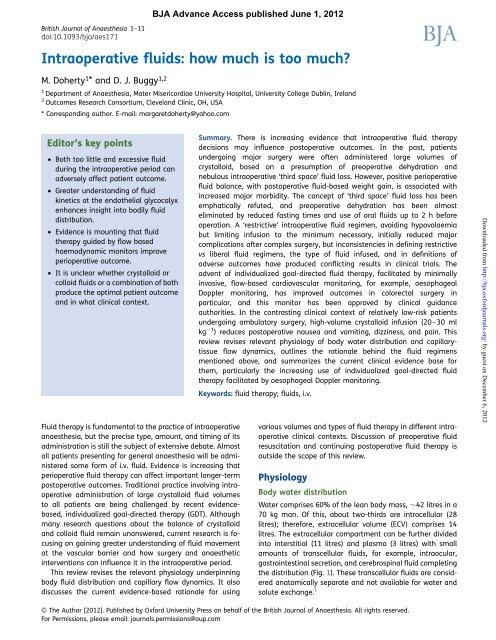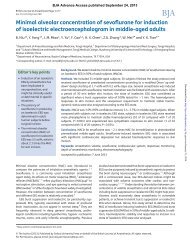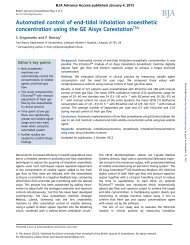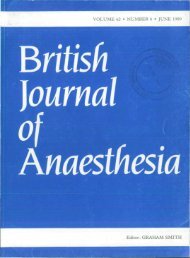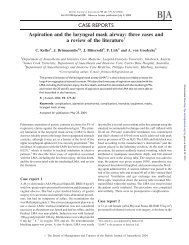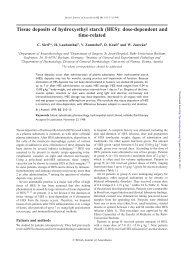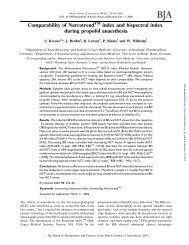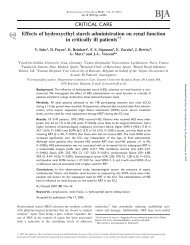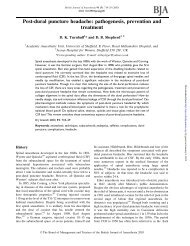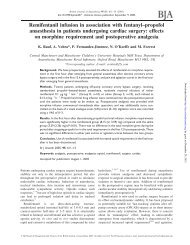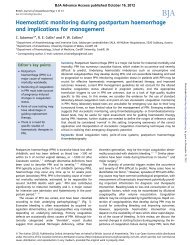Intraoperative fluids: how much is too much? - British Journal of ...
Intraoperative fluids: how much is too much? - British Journal of ...
Intraoperative fluids: how much is too much? - British Journal of ...
You also want an ePaper? Increase the reach of your titles
YUMPU automatically turns print PDFs into web optimized ePapers that Google loves.
Brit<strong>is</strong>h <strong>Journal</strong> <strong>of</strong> Anaesthesia 1–11<br />
doi:10.1093/bja/aes171<br />
<strong>Intraoperative</strong> <strong>fluids</strong>: <strong>how</strong> <strong>much</strong> <strong>is</strong> <strong>too</strong> <strong>much</strong>?<br />
M. Doherty 1* and D. J. Buggy 1,2<br />
1 Department <strong>of</strong> Anaesthesia, Mater M<strong>is</strong>ericordiae University Hospital, University College Dublin, Ireland<br />
2 Outcomes Research Consortium, Cleveland Clinic, OH, USA<br />
* Corresponding author. E-mail: margaretdoherty@yahoo.com<br />
Editor’s key points<br />
† Both <strong>too</strong> little and excessive fluid<br />
during the intraoperative period can<br />
adversely affect patient outcome.<br />
† Greater understanding <strong>of</strong> fluid<br />
kinetics at the endothelial glycocalyx<br />
enhances insight into bodily fluid<br />
d<strong>is</strong>tribution.<br />
† Evidence <strong>is</strong> mounting that fluid<br />
therapy guided by flow based<br />
haemodynamic monitors improve<br />
perioperative outcome.<br />
† It <strong>is</strong> unclear whether crystalloid or<br />
colloid <strong>fluids</strong> or a combination <strong>of</strong> both<br />
produce the optimal patient outcome<br />
and in what clinical context.<br />
Fluid therapy <strong>is</strong> fundamental to the practice <strong>of</strong> intraoperative<br />
anaesthesia, but the prec<strong>is</strong>e type, amount, and timing <strong>of</strong> its<br />
admin<strong>is</strong>tration <strong>is</strong> still the subject <strong>of</strong> extensive debate. Almost<br />
all patients presenting for general anaesthesia will be admin<strong>is</strong>tered<br />
some form <strong>of</strong> i.v. fluid. Evidence <strong>is</strong> increasing that<br />
perioperative fluid therapy can affect important longer-term<br />
postoperative outcomes. Traditional practice involving intraoperative<br />
admin<strong>is</strong>tration <strong>of</strong> large crystalloid fluid volumes<br />
to all patients are being challenged by recent evidencebased,<br />
individualized goal-directed therapy (GDT). Although<br />
many research questions about the balance <strong>of</strong> crystalloid<br />
and colloid fluid remain unanswered, current research <strong>is</strong> focusing<br />
on gaining greater understanding <strong>of</strong> fluid movement<br />
at the vascular barrier and <strong>how</strong> surgery and anaesthetic<br />
interventions can influence it in the intraoperative period.<br />
Th<strong>is</strong> review rev<strong>is</strong>es the relevant physiology underpinning<br />
body fluid d<strong>is</strong>tribution and capillary flow dynamics. It also<br />
d<strong>is</strong>cusses the current evidence-based rationale for using<br />
BJA Advance Access publ<strong>is</strong>hed June 1, 2012<br />
Summary. There <strong>is</strong> increasing evidence that intraoperative fluid therapy<br />
dec<strong>is</strong>ions may influence postoperative outcomes. In the past, patients<br />
undergoing major surgery were <strong>of</strong>ten admin<strong>is</strong>tered large volumes <strong>of</strong><br />
crystalloid, based on a presumption <strong>of</strong> preoperative dehydration and<br />
nebulous intraoperative ‘third space’ fluid loss. However, positive perioperative<br />
fluid balance, with postoperative fluid-based weight gain, <strong>is</strong> associated with<br />
increased major morbidity. The concept <strong>of</strong> ‘third space’ fluid loss has been<br />
emphatically refuted, and preoperative dehydration has been almost<br />
eliminated by reduced fasting times and use <strong>of</strong> oral <strong>fluids</strong> up to 2 h before<br />
operation. A ‘restrictive’ intraoperative fluid regimen, avoiding hypovolaemia<br />
but limiting infusion to the minimum necessary, initially reduced major<br />
complications after complex surgery, but incons<strong>is</strong>tencies in defining restrictive<br />
vs liberal fluid regimens, the type <strong>of</strong> fluid infused, and in definitions <strong>of</strong><br />
adverse outcomes have produced conflicting results in clinical trials. The<br />
advent <strong>of</strong> individualized goal-directed fluid therapy, facilitated by minimally<br />
invasive, flow-based cardiovascular monitoring, for example, oesophageal<br />
Doppler monitoring, has improved outcomes in colorectal surgery in<br />
particular, and th<strong>is</strong> monitor has been approved by clinical guidance<br />
authorities. In the contrasting clinical context <strong>of</strong> relatively low-r<strong>is</strong>k patients<br />
undergoing ambulatory surgery, high-volume crystalloid infusion (20–30 ml<br />
kg 21 ) reduces postoperative nausea and vomiting, dizziness, and pain. Th<strong>is</strong><br />
review rev<strong>is</strong>es relevant physiology <strong>of</strong> body water d<strong>is</strong>tribution and capillaryt<strong>is</strong>sue<br />
flow dynamics, outlines the rationale behind the fluid regimens<br />
mentioned above, and summarizes the current clinical evidence base for<br />
them, particularly the increasing use <strong>of</strong> individualized goal-directed fluid<br />
therapy facilitated by oesophageal Doppler monitoring.<br />
Keywords: fluid therapy; <strong>fluids</strong>, i.v.<br />
various volumes and types <strong>of</strong> fluid therapy in different intraoperative<br />
clinical contexts. D<strong>is</strong>cussion <strong>of</strong> preoperative fluid<br />
resuscitation and continuing postoperative fluid therapy <strong>is</strong><br />
outside the scope <strong>of</strong> th<strong>is</strong> review.<br />
Physiology<br />
Body water d<strong>is</strong>tribution<br />
Water compr<strong>is</strong>es 60% <strong>of</strong> the lean body mass, ≏42 litres in a<br />
70 kg man. Of th<strong>is</strong>, about two-thirds are intracellular (28<br />
litres); therefore, extracellular volume (ECV) compr<strong>is</strong>es 14<br />
litres. The extracellular compartment can be further divided<br />
into interstitial (11 litres) and plasma (3 litres) with small<br />
amounts <strong>of</strong> transcellular <strong>fluids</strong>, for example, intraocular,<br />
gastrointestinal secretion, and cerebrospinal fluid completing<br />
the d<strong>is</strong>tribution (Fig. 1). These transcellular <strong>fluids</strong> are considered<br />
anatomically separate and not available for water and<br />
solute exchange. 1<br />
& The Author [2012]. Publ<strong>is</strong>hed by Oxford University Press on behalf <strong>of</strong> the Brit<strong>is</strong>h <strong>Journal</strong> <strong>of</strong> Anaesthesia. All rights reserved.<br />
For Perm<strong>is</strong>sions, please email: journals.perm<strong>is</strong>sions@oup.com<br />
Downloaded from<br />
http://bja.oxfordjournals.org/ by guest on December 6, 2012
BJA Doherty and Buggy<br />
Total body water (TBW) can be estimated by using dilution<br />
tracer techniques. Isotopically labelled water using deuterium<br />
or tritium diffuses through the TBW compartment. Extracellular<br />
fluid (ECF) measurement requires that the marker<br />
used must cross capillaries but not cell membranes. Radiolabelled<br />
sulphate ( 35 SO 4 22 ) or bromide ( 82 Br 2 ) ions are the most<br />
commonly used extracellular tracers. Intracellular fluid<br />
volume (ICV) <strong>is</strong> calculated indirectly by subtracting ECV<br />
from TBW. The intravascular volume can be measured<br />
using radiolabelled albumin or with the dye Evans Blue.<br />
Interstitial volume <strong>is</strong> then calculated by subtracting intravascular<br />
volume from ECV.<br />
The capillary endothelium <strong>is</strong> freely permeable to water,<br />
anions, cations, and other soluble substances such as<br />
glucose but <strong>is</strong> impermeable to protein and other large molecules<br />
.35 kDa, which are largely confined to the intravascular<br />
space. 2 In the ECF, Na + <strong>is</strong> the principal cation and Cl 2 the<br />
main anion. In contrast, in the intracellular compartment, K +<br />
<strong>is</strong> the major cation and PO4 22 the principal anion, with a high<br />
protein content. 3 As the cellular membrane <strong>is</strong> freely permeable<br />
to water but not to ions, osmotic equilibrium <strong>is</strong> maintained.<br />
In a healthy individual, daily fluctuations in TBW are<br />
small (,0.2%) and are finely balanced with modifications<br />
<strong>of</strong> thirst mechan<strong>is</strong>ms and fluid balance, controlled by the<br />
renin–angiotensin anti-diuretic and atrial natriuretic<br />
peptide (ANP) hormone systems. The basal fluid requirement<br />
in a normothermic adult with a normal metabolic rate <strong>is</strong><br />
1.5 ml kg 21 h 21 .<br />
2<br />
COLLOID<br />
Plasma<br />
3 litre<br />
Blood<br />
Cells<br />
2 litre<br />
ECF<br />
14 litre<br />
SALINE<br />
Interstitial<br />
Fluid<br />
11 litre<br />
CI –<br />
Na +<br />
Mg 2+<br />
Ca 2+<br />
HCO 3 −<br />
GLUCOSE<br />
PROTEINS<br />
K +<br />
PO 4 2–<br />
150 75 0 75 150<br />
Capillary t<strong>is</strong>sue fluid dynamics<br />
Fluid shifts between the intravascular and remainder <strong>of</strong> the<br />
extracellular space occurs at the vascular endothelial<br />
barrier. The forces governing th<strong>is</strong> were described by Starling 4<br />
in 1896 and remain the bas<strong>is</strong> <strong>of</strong> our understanding <strong>of</strong> fluid<br />
movement in the microvasculature. The fluid components<br />
<strong>of</strong> the blood are contained within the vessels <strong>of</strong> the microcirculation<br />
mainly by the inward pull <strong>of</strong> colloid osmotic pressure<br />
(COP) produced by the protein content <strong>of</strong> the plasma (Fig. 2).<br />
Th<strong>is</strong> opposes the high outward hydrostatic pressure, which<br />
tends to push plasma out <strong>of</strong> the vessels and into the interstitium.<br />
Both the hydrostatic and colloid osmotic pressure in the<br />
interstitium are low. The net result <strong>of</strong> these forces <strong>is</strong> a small<br />
outward leak <strong>of</strong> fluid and protein from the vasculature to the<br />
interstitium which <strong>is</strong> continually returned to the blood<br />
vessels via the lymphatic system. 5 The vascular endothelium<br />
<strong>is</strong> permeable to water but impermeable to protein and other<br />
large molecules. Movement across the vascular endothelium<br />
<strong>of</strong> small molecules such as sodium, potassium, chloride, and<br />
glucose occurs freely across specialized pathways between<br />
the endothelial cells. Macromolecule transport may occur<br />
via large pores in the endothelium or by transport by vesicles.<br />
2 Fluid movement across the capillary endothelium can<br />
be classified into two types. Type 1 (physiological) occurs<br />
continuously with an intact vascular barrier and <strong>is</strong> returned<br />
to the vascular compartment by the lymphatic system,<br />
thereby avoiding interstitial oedema. Type 2 (pathological)<br />
fluid movement occurs when the vascular barrier becomes<br />
ICF<br />
28 litre<br />
Fig 1 Body fluid compartments with main ion d<strong>is</strong>tribution. ICF, intracellular fluid. ECF, extracellular fluid.<br />
Downloaded from<br />
http://bja.oxfordjournals.org/ by guest on December 6, 2012
<strong>Intraoperative</strong> <strong>fluids</strong> BJA<br />
Endothelial cell layer<br />
Endothelial cell layer<br />
damaged or dysfunctional, allowing excessive fluid accumulation<br />
leading to interstitial oedema. 6<br />
The endothelial glycocalyx<br />
Recent research has expanded our understanding <strong>of</strong> fluid<br />
movement at the endothelial barrier. The endothelium <strong>is</strong><br />
one cell thick and <strong>is</strong> coated on its luminal side with a<br />
fragile layer, the glycocalyx, which provides a first line<br />
barrier to regulating cellular and macromolecule transport<br />
at the endothelium. 7 The endothelial glycocalyx layer (EGL)<br />
<strong>is</strong> composed <strong>of</strong> membrane-bound glycoproteins and proteoglycans<br />
and contains glycosamionoglycans. It creates an exclusion<br />
zone for erythrocytes, therefore non-circulating,<br />
protein-rich plasma predominates within it. The intravascular<br />
volume cons<strong>is</strong>ts <strong>of</strong> the glycocalyx volume, plasma volume,<br />
and the red cell d<strong>is</strong>tribution volume. 8 Together the glycocalyx<br />
and endothelial cells compr<strong>is</strong>e the endothelial surface layer<br />
(ESL). The ESL <strong>is</strong> 0.4–1.2 mm thick and <strong>is</strong> in dynamic equilibrium<br />
with the circulating plasma. To function, the ESL<br />
requires a normal level <strong>of</strong> plasma albumin. 9 Current theory<br />
promotes a ‘double barrier concept’ where both the endothelial<br />
cell layer and the EGL play a role in maintaining the vas-<br />
10 11<br />
cular barrier.<br />
Improved understanding <strong>of</strong> microvascular physiology<br />
allows explanation <strong>of</strong> the d<strong>is</strong>crepancy between clinical findings<br />
during fluid therapy and the original Starling principle. 8<br />
Transendothelial pressure difference and the plasma subglycocalyx<br />
colloid oncotic pressure difference are central to fluid<br />
filtration, with interstitial COP negligible. At subnormal capillary<br />
pressure, transcapillary flow approaches zero. When capillary<br />
pressure <strong>is</strong> supranormal, the COP <strong>is</strong> maximal and fluid<br />
movement <strong>is</strong> dependent on transendothelial pressure<br />
P i Interstitial<br />
P c<br />
Interstitial<br />
J v a K f [(P c –P i )–s(p c –p i )]<br />
p i<br />
p c<br />
Intraluminal<br />
Fig 2 Classic Starling equation with net efflux <strong>of</strong> fluid to the interstitial space. J v, net filtration; K f, filtration coefficient; P c, capillary hydrostatic<br />
pressure; P i, interstitial hydrostatic pressure; s, reflection coefficient; p c, capillary oncotic pressure; p i, interstitial oncotic pressure.<br />
difference. When a colloid solution <strong>is</strong> infused in th<strong>is</strong> situation,<br />
it d<strong>is</strong>tributes through the plasma volume, maintaining COP<br />
while increasing capillary pressure and therefore fluid filtration<br />
increases. A crystalloid solution in the same situation<br />
d<strong>is</strong>tributes throughout the intravascular volume and<br />
increases capillary pressure but lowers COP, so fluid filtration<br />
<strong>is</strong> increased more than with a colloid. When capillary pressure<br />
<strong>is</strong> low, both types <strong>of</strong> fluid are retained in the intravascular<br />
space until the transendothelial pressure increases to the<br />
point where transcapillary flow resumes. Th<strong>is</strong> physiological<br />
model therefore supports the use <strong>of</strong> crystalloid infusion<br />
over colloid for resuscitation while colloids have a role in<br />
euvolaemic or hypervolaemic haemodilution. As the red cell<br />
volume <strong>is</strong> less than intravascular volume, studies using th<strong>is</strong><br />
parameter as an endpoint need to be interpreted with<br />
caution.<br />
The endothelium <strong>is</strong> not only a barrier between the blood<br />
and t<strong>is</strong>sues but also has roles in primary haemostas<strong>is</strong>, coagulation,<br />
fibrinolys<strong>is</strong>, inflammation, and regulation <strong>of</strong> vasomotor<br />
tone. 7 Numerous factors have been s<strong>how</strong>n to<br />
damage the endothelial glycocalyx causing platelet aggregation,<br />
leucocyte adhesion, and increased vascular permeability<br />
leading to interstitial oedema. These factors 12 – 17 are<br />
summarized in Table 1.<br />
Perioperative protection <strong>of</strong> the endothelial glycocalyx <strong>is</strong> a<br />
plausible strategy for prevention <strong>of</strong> interstitial oedema. Experimental<br />
studies have s<strong>how</strong>n that pretreatment with<br />
hydrocort<strong>is</strong>one and antithrombin preserve the integrity <strong>of</strong><br />
the endothelium by reducing shedding <strong>of</strong> the glycocalyx<br />
and adhesion <strong>of</strong> leucocytes after <strong>is</strong>chaemia/reperfusion<br />
injury. 18 Sev<strong>of</strong>lurane also s<strong>how</strong>s protective effects by stabilizing<br />
the endothelial glycocalyx and dimin<strong>is</strong>hing adhesion <strong>of</strong><br />
3<br />
Downloaded from<br />
http://bja.oxfordjournals.org/<br />
by guest on December 6, 2012
BJA Doherty and Buggy<br />
Table 1 Factors affecting the endothelial glycocalyx—known<br />
injurious mechan<strong>is</strong>ms and potential protective agents<br />
Degradation Protection<br />
Ischaemia/reperfusion;<br />
hypoxia/reoxygenation;<br />
inflammatory cytokines proteases;<br />
atrial natriuretic peptide<br />
leucocytes and platelets after <strong>is</strong>chaemia/reperfusion injury in<br />
the <strong>is</strong>olated guinea pig heart. 19 There are currently no<br />
pharmacological agents that increase synthes<strong>is</strong> or directly<br />
prevent enzymatic degradation <strong>of</strong> the glycocalyx. Therefore,<br />
avoiding precipitants <strong>of</strong> glycocalyceal damage and incorporation<br />
<strong>of</strong> potentially protective agents (Table 1) should be<br />
considered. 20<br />
D<strong>is</strong>tribution <strong>of</strong> crystalloid fluid<br />
Sev<strong>of</strong>lurane;<br />
hydrocort<strong>is</strong>one;<br />
antithrombin<br />
The composition <strong>of</strong> fluid infused to a patient determines its<br />
bodily d<strong>is</strong>tribution. When 1 litre glucose 5% <strong>is</strong> admin<strong>is</strong>tered,<br />
the glucose <strong>is</strong> metabolized in the liver, leaving only water<br />
which d<strong>is</strong>tributes to the ECV and ICV in proportion to the<br />
volume infused. Therefore, only 7% (about 70 ml) remains<br />
in the vascular compartment after equilibration with the<br />
other body fluid compartments, because plasma compr<strong>is</strong>es<br />
3 <strong>of</strong> 42 litres TBW. Infusion <strong>of</strong> an <strong>is</strong>otonic sodium containing<br />
solution on the other hand <strong>is</strong> confined to the extracellular<br />
space because sodium <strong>is</strong> prevented from traversing the intracellular<br />
space by the cell membrane. Therefore, when 1 litre<br />
<strong>of</strong> 0.9% saline <strong>is</strong> admin<strong>is</strong>tered, 20% should remain in the vascular<br />
compartment after equilibration with the other body<br />
fluid compartments as the plasma compartment accounts<br />
for 20% <strong>of</strong> ECF.<br />
However, the effects <strong>of</strong> different types <strong>of</strong> both colloid and<br />
crystalloid solutions have been studied in healthy volunteers,<br />
hypovolaemic states, and d<strong>is</strong>eased states. Eighteen healthy<br />
volunteers received 50 ml kg 21 lactated Ringer’s (LR) solution<br />
and 0.9% saline (NS) on two separate occasions. 21 It was<br />
found that LR transiently decreased serum osmolality<br />
which returned to baseline 1 h later. NS did not affect<br />
serum osmolality but caused metabolic acidos<strong>is</strong>. Lobo and<br />
colleagues 22 performed a double-blind, crossover study on<br />
10 healthy male volunteers to investigate the effect <strong>of</strong><br />
bolus <strong>of</strong> crystalloid on serum albumin. Each was given 2<br />
litres 0.9% saline and dextrose 5% on two separate occasions<br />
in random order. With both solutions, serum albumin<br />
was decreased which was accounted for by dilution alone<br />
and indicates red<strong>is</strong>tribution within fluid compartments. The<br />
decrease in albumin was prolonged .6 h with NS, but<br />
levels had returned to baseline 1 h after infusion with dextrose.<br />
Haemoglobin also decreased in proportion to the dilutional<br />
effect. The water load from the dextrose infusion was<br />
excreted 2 h post infusion, but NS had a pers<strong>is</strong>tent diluting<br />
effect with only 30% <strong>of</strong> both sodium and water being<br />
4<br />
excreted at 6 h. Similar endpoints were assessed in a study<br />
comparing 0.9% saline with Hartmann’s solution. 23 Plasma<br />
expansion was s<strong>how</strong>n to be more sustained with NS than<br />
Hartmann’s, as estimated by dilution <strong>of</strong> haemoglobin and<br />
albumin. The NS group retained 56% <strong>of</strong> infused volume at<br />
6 h compared with 30% for Hartmann’s, based on body<br />
weight. There were no significant differences in serum<br />
potassium, sodium, urea, or total osmolality. In the NS<br />
group, bicarbonate levels were lower and all subjects were<br />
hyperchloraemic, which was sustained .6 h. These<br />
biochemical changes place the body under physiological<br />
stress to eliminate the supranormal electrolyte load<br />
and may adversely affect organ function and surgical<br />
22 24 – 26<br />
outcome.<br />
D<strong>is</strong>tribution <strong>of</strong> colloid<br />
Colloid <strong>fluids</strong> contain macromolecules (usually .40 kDa)<br />
such as polysaccharides or polypeptides from either plant<br />
or animal sources and are used as plasma expanders. To<br />
prevent haemolys<strong>is</strong>, the macromolecules are suspended in<br />
an electrolyte solution which may be 0.9% sodium chloride<br />
or a more balanced solution similar to Hartmann’s.<br />
Because they contain larger molecules which cannot pass<br />
the endothelium, they remain in the plasma longer than<br />
crystalloids. Unlike crystalloid solutions, colloids carry a r<strong>is</strong>k<br />
<strong>of</strong> anaphylax<strong>is</strong>, have a dose-dependent effect on coagulation<br />
and molecules may be deposited in t<strong>is</strong>sues causing prurit<strong>is</strong>. 27<br />
On the other hand, there <strong>is</strong> evidence s<strong>how</strong>ing a beneficial<br />
effect <strong>of</strong> plasma expanders on inflammation, the microcirculation,<br />
and endothelial activation.<br />
Studies have s<strong>how</strong>n that colloid admin<strong>is</strong>tration <strong>is</strong> contextsensitive.<br />
Despite the large molecules in these solutions,<br />
which should confine them to the vascular compartment,<br />
volume loading with both 6% hydroxyethyl starch (HES)<br />
and albumin 5% in the normovolaemic patient resulted in<br />
68% <strong>of</strong> the infused volume extravasating the intravascular<br />
space into the interstitium within minutes. Conversely,<br />
when 6% HES or albumin 5% was given in the context <strong>of</strong> normovolaemic<br />
haemodilution, the volume remaining in the<br />
intravascular space approached 90%. 28<br />
The effect <strong>of</strong> volume loading with 0.9% saline, 0.4% succinylated<br />
gelatine (gel<strong>of</strong>usine), and 6% hydroxyethyl starch<br />
(voluven) on blood volume and endocrine response in<br />
healthy volunteers was recently investigated. 29 After completion<br />
<strong>of</strong> a 1 h infusion, 68%, 21%, and 16% <strong>of</strong> 0.9% saline,<br />
gel<strong>of</strong>usine, and voluven, respectively, had leaked from the<br />
intravascular space. Blood volume calculations were based<br />
on haematocrit dilution. There was little difference between<br />
both colloids, even though they have wide ranging average<br />
molecular weights (gel<strong>of</strong>usine 30 kDa, voluven 130 kDa).<br />
Th<strong>is</strong> may reflect the different handling <strong>of</strong> small and large<br />
molecules in the microvasculature.<br />
The renin–angiotensin–aldosterone system (RAAS) <strong>is</strong> fundamental<br />
to the regulation <strong>of</strong> sodium excretion after a<br />
sodium load. All three solutions had similar effects on renin<br />
secretion, with levels <strong>of</strong> both renin and aldosterone being<br />
Downloaded from<br />
http://bja.oxfordjournals.org/ by guest on December 6, 2012
<strong>Intraoperative</strong> <strong>fluids</strong> BJA<br />
reduced. Brain natriuretic peptide (BNP) was also measured<br />
and s<strong>how</strong>ed an increase in all three groups 1 h after commencement<br />
<strong>of</strong> the infusion. Th<strong>is</strong> correlates with other<br />
works indicating the role <strong>of</strong> BNP and ANP in acute hypervolaemia.<br />
30 It was concluded that the excretion <strong>of</strong> the<br />
sodium and chloride load may depend on suppression <strong>of</strong><br />
the RAAS and not on natriuretic peptides.<br />
It <strong>is</strong> commonly believed that intravascular losses require<br />
3–4 times volume replacement with crystalloid <strong>fluids</strong> compared<br />
with colloids. A recent systematic review <strong>of</strong> the use<br />
<strong>of</strong> HES in surgical, emergency, and intensive care patients<br />
reported that the crystalloid to colloid ratio for volume resuscitation<br />
was lower, ,2:1. 31 Th<strong>is</strong> may reflect the increased<br />
vasopermeability to colloid that has been observed in the<br />
clinical setting. However, fluid loading with colloid s<strong>how</strong>ed<br />
a greater linear increase in cardiac filling, cardiac output,<br />
and stroke work in both septic and non-septic patients<br />
when compared with normal saline. 32 Also, in a randomized<br />
trial <strong>of</strong> HES and NS in trauma patients, HES s<strong>how</strong>ed greater<br />
lactate clearance and less renal injury when compared with<br />
NS in patients with penetrating injuries. 33<br />
Traditional practice <strong>of</strong> intraoperative fluid<br />
admin<strong>is</strong>tration<br />
The aim <strong>of</strong> intraoperative fluid therapy <strong>is</strong> to maintain an adequate<br />
circulating volume to ensure end-organ perfusion<br />
and oxygen delivery to the t<strong>is</strong>sues. Traditionally, th<strong>is</strong> was<br />
achieved by routine infusion <strong>of</strong> large volumes <strong>of</strong> crystalloid.<br />
Th<strong>is</strong> was based on the outdated prem<strong>is</strong>e that the preoperative<br />
patient was hypovolaemic due to prolonged fasting (‘nil<br />
by mouth after midnight’) and cathartic bowel preparation, in<br />
addition to ongoing losses from perspiration and urinary<br />
output. There was also a widespread belief that surgical exposure<br />
required aggressive replacement <strong>of</strong> insensible fluid<br />
loss, <strong>of</strong>ten termed ‘third space’ losses. Further, hypotension<br />
during general and neuraxial anaesthesia <strong>of</strong>ten triggered<br />
compensatory liberal i.v. fluid admin<strong>is</strong>tration. However, fluid<br />
loading has no influence on anaesthesia-related hypotension<br />
34 35 and should more appropriately be treated with<br />
vasopressor therapy. 36<br />
Prolonged preoperative fasting ought no longer feature in<br />
modern perioperative care. For over a decade, research has<br />
clearly s<strong>how</strong>n that fasting from solid food for 6 h and oral<br />
fluid, even containing carbohydrate, for only 2 h before operation,<br />
<strong>is</strong> safe and actually improves outcomes. 37 38 Studies<br />
have s<strong>how</strong>n that in fact, in healthy cardiopulmonary<br />
patients, blood volume <strong>is</strong> normal even after prolonged<br />
fasting. 36 The use <strong>of</strong> mechanical bowel preparations has<br />
also dimin<strong>is</strong>hed as evidence s<strong>how</strong>s minimal difference in surgical<br />
conditions where th<strong>is</strong> <strong>is</strong> used. 39<br />
The phantom ‘third space’<br />
The concept <strong>of</strong> a ‘third space’ for body <strong>fluids</strong> (in addition to<br />
intracellular and ECF compartments) was introduced in the<br />
1960s. 40 Using outdated sulphate tracer techniques, the<br />
ECV was measured in patients undergoing major abdominal<br />
surgery. It was concluded that there was a decrease in ECV<br />
which was not fully accounted for by the measured blood<br />
loss. To explain th<strong>is</strong>, it was hypothesized that fluid was<br />
sequestered in areas that became known as the ‘third<br />
space’. Its location was unknown but speculated to include<br />
traumatized t<strong>is</strong>sue or the gastrointestinal tract. Despite th<strong>is</strong><br />
highly implausible concept, lacking any credible supportive<br />
scientific or clinical evidence, the practice <strong>of</strong> aggressive replacement<br />
<strong>of</strong> th<strong>is</strong> hypothetical fluid loss gained widespread<br />
traction in intraoperative anaesthetic practice. Infusion <strong>of</strong><br />
large volumes <strong>of</strong> crystalloid infusions intraoperatively<br />
became standard clinical practice. 10 Consequently, it was<br />
not uncommon for postoperative patients to have 7–10 kg<br />
weight gain, with proportionately increased r<strong>is</strong>k <strong>of</strong> all-cause<br />
morbidity and mortality. 41 42 In a systematic review <strong>of</strong><br />
trials measuring ECV changes, it was concluded that the original<br />
data and methodology supporting the concept <strong>of</strong> third<br />
space were fundamentally flawed. 43<br />
In the intraoperative patient, maintenance <strong>fluids</strong> should<br />
be infused using balanced crystalloid infusions. More than<br />
30 yr ago, direct measurements <strong>of</strong> basal evaporation rate<br />
from the skin and airway during surgery s<strong>how</strong>ed that<br />
topical fluid loss <strong>is</strong> 0.5–1.0 ml kg 21 h 21 during major abdominal<br />
surgery. 44 In the absence <strong>of</strong> major haemorrhage, large<br />
volume fluid loading <strong>is</strong> contraindicated, because it may<br />
lead to hypervolaemia causing ANP release and damage to<br />
the endothelial glycocalyx, with detrimental interstitial<br />
oedema.<br />
‘Restrictive’ fluid regimen<br />
In thoracic surgery, fluid restriction <strong>is</strong> the standard practice,<br />
but the intraoperative fluid volume in the general surgical<br />
population <strong>is</strong> widely variable. A randomized, multicentre<br />
trial comparing liberal and restrictive fluid regimens in 141<br />
patients undergoing colorectal surgery was undertaken. 45<br />
The restrictive group received a mean volume <strong>of</strong> 2.7 litres<br />
and the liberal 5.4 litres. The number <strong>of</strong> patients with postoperative<br />
complications was significantly reduced in the restrictive<br />
group, 33% vs 51% P¼0.02. Outcomes assessed<br />
included anastomotic leakage, wound infection, and cardiovascular<br />
and pulmonary complications. There was no<br />
observed increase in renal complications in the restrictive<br />
group. However, the two groups received different <strong>fluids</strong><br />
with the restrictive group receiving a greater amount <strong>of</strong><br />
colloid and the liberal group, normal saline.<br />
In 2009, a review <strong>of</strong> restrictive vs liberal fluid therapy and<br />
its effect on postoperative outcome 46 identified seven randomized<br />
trials, six involving major abdominal surgery and one<br />
involving knee arthroplasty. The trials excluded high-r<strong>is</strong>k<br />
patients. The range <strong>of</strong> fluid admin<strong>is</strong>tered in the liberal<br />
groups was from 2750 to 5388 ml and in the restrictive<br />
groups from 998 to 2740 ml. Th<strong>is</strong> highlights the fact that<br />
no common definition <strong>of</strong> ‘liberal’ or ‘restrictive’ protocols<br />
ex<strong>is</strong>ts in clinical practice. A restrictive regime in one centre<br />
may actually be liberal in another. The studies varied in<br />
terms <strong>of</strong> design, types <strong>of</strong> fluid admin<strong>is</strong>tered, indications for<br />
5<br />
Downloaded from<br />
http://bja.oxfordjournals.org/ by guest on December 6, 2012
BJA Doherty and Buggy<br />
admin<strong>is</strong>tering additional fluid, outcomes variables, and definitions<br />
<strong>of</strong> intra- and postoperative periods. Therefore, there <strong>is</strong><br />
difficulty interpreting the results. Three <strong>of</strong> the trials s<strong>how</strong>ed<br />
improved outcome after restrictive fluid regimes. Two<br />
s<strong>how</strong>ed no difference in outcome and two s<strong>how</strong>ed differences<br />
in some selected outcomes only. The studies<br />
s<strong>how</strong>ing improved outcome with restrictive fluid regimen<br />
reported faster return <strong>of</strong> gastrointestinal function and<br />
reduced hospital length <strong>of</strong> stay (LOS). These studies used<br />
colloid and crystalloid infusion. The studies which s<strong>how</strong>ed<br />
no difference in outcome used crystalloid <strong>fluids</strong> alone,<br />
without colloids. In one study, 47 both restrictive and liberal<br />
fluid regimens received relatively restricted amounts <strong>of</strong><br />
fluid (mean 2.6 vs 2.0 litres), suggesting that the standard<br />
group did not receive the excessive amounts <strong>of</strong> fluid known<br />
to cause harm.<br />
Two further randomized double-blind studies s<strong>how</strong>ed benefits<br />
to both restrictive and liberal fluid regimes in different<br />
clinical context. 48 49 Both studies used crystalloid and<br />
colloid. In the study looking at patients undergoing major<br />
colonic surgery, the restrictive fluid regimen demonstrated<br />
a beneficial effect in pulmonary function and postoperative<br />
hypoxaemia. There was an overall decrease in the number<br />
<strong>of</strong> postoperative complications, but the number <strong>of</strong> patients<br />
with complications was not significantly reduced. There<br />
was no difference in other outcome variables such as pain,<br />
nausea, and LOS. In the second study, similar fluid regimens<br />
were used in patients undergoing knee arthroplasty. Results<br />
s<strong>how</strong>ed significant hypercoagulability 1–2 days postprocedure<br />
in the liberal group and a reduction in post operative<br />
nausea and vomiting. There was no difference in the LOS.<br />
Taken together, it was concluded that due to incons<strong>is</strong>tent<br />
definitions <strong>of</strong> both liberal and restrictive fluid regimens and<br />
lack <strong>of</strong> standardization <strong>of</strong> clinical and physiological<br />
outcome measurement, no evidence-based guidelines for<br />
procedure-specific perioperative fluid therapy could be<br />
<strong>is</strong>sued. Th<strong>is</strong> view, in combination with other publ<strong>is</strong>hed research<br />
in liberal vs restrictive fluid therapy, suggests that<br />
‘one approach fits all’ <strong>is</strong> not appropriate for fluid management<br />
in high-r<strong>is</strong>k surgical patients.<br />
High-volume crystalloids for ambulatory<br />
moderate-r<strong>is</strong>k surgery<br />
In the contrasting clinical context <strong>of</strong> minor or moderate<br />
surgery in low r<strong>is</strong>k, ambulatory patient, a more liberal strategy<br />
seems to be beneficial. Major morbidity <strong>is</strong> rarely seen<br />
in th<strong>is</strong> group <strong>of</strong> patients, but the rapid return <strong>of</strong> vital function<br />
<strong>is</strong> crucial to the successful management <strong>of</strong> the ambulatory<br />
patient, allowing timely d<strong>is</strong>charge from hospital. Up to 20–<br />
30 ml kg 21 <strong>of</strong> crystalloid fluid to a healthy adult having<br />
low-r<strong>is</strong>k surgery or day-case procedure reduces postoperative<br />
complications such as dizziness, drowsiness, pain, nausea,<br />
and vomiting. 50 51 In moderate surgery, Holte and colleagues<br />
52 evaluated patients undergoing laparoscopic cholecystectomy<br />
and compared the effect <strong>of</strong> 40 and 15 ml kg 21<br />
<strong>of</strong> LR solution intraoperatively. They found an enhanced<br />
6<br />
recovery pr<strong>of</strong>ile with less nausea, dizziness, and drowsiness<br />
and improved general wellbeing in those receiving liberal<br />
amounts <strong>of</strong> fluid and a reduced LOS. Studies in major<br />
surgery favour a restrictive regime, 53 54 but th<strong>is</strong> <strong>is</strong> not a universal<br />
finding. 55 One investigation using bioelectrical impedance<br />
measurements in 30 patients undergoing abdominal<br />
surgery developed a mathematical model which s<strong>how</strong>ed<br />
that infusion rates <strong>of</strong> between 2 and 18.5 ml kg 21 h 21 in<br />
surgery <strong>of</strong> duration ,3 h did not cause significant interstitial<br />
oedema, but in surgery lasting .6 h, the therapeutic window<br />
narrowed to between 5 and 8 ml kg 21 h 21 , after which a significant<br />
increase in interstitial fluid was seen. 56<br />
Individualized goal-directed fluid therapy<br />
In recent times, evidence <strong>is</strong> mounting that outcomes may be<br />
improved if fluid therapy <strong>is</strong> individualized based on objective<br />
feedback on the patient’s individual fluid responsiveness. Th<strong>is</strong><br />
<strong>is</strong> derived from the old physiological principle <strong>of</strong> the Frank–<br />
Starling curve. Th<strong>is</strong> has become known as individualized<br />
‘GDT’. 57 Traditional measurements do not have the ability<br />
to adequately identify and guide fluid therapy. A healthy<br />
patient may lose up to 25% <strong>of</strong> blood volume before there<br />
<strong>is</strong> a decrease in arterial pressure or an increase in heart<br />
rate, whereas more sensitive monitors may s<strong>how</strong> decreased<br />
stroke volume and gastric mucosal pH, indicating <strong>is</strong>chaemia.<br />
58 A systematic review <strong>of</strong> the role <strong>of</strong> central venous pressure<br />
(CVP) measurement in fluid therapy concluded that<br />
neither the CVP number nor the rate <strong>of</strong> change <strong>of</strong> CVP was<br />
accurate in assessing blood volume or in predicting the response<br />
to a fluid challenge. Therefore, caution should be<br />
exerc<strong>is</strong>ed in interpreting CVP data to guide fluid<br />
admin<strong>is</strong>tration. 59<br />
Both hypovolaemia and hypervolaemia are known to<br />
cause increased perioperative morbidity and mortality; therefore,<br />
assessment <strong>of</strong> the patients actual haemodynamic<br />
status can guide appropriate therapy (Fig. 3). 60 In the<br />
1980s, GDT required the use <strong>of</strong> pulmonary artery catheters<br />
(PACs) to measure t<strong>is</strong>sue oxygen delivery in high-r<strong>is</strong>k surgical<br />
patients, in order to achieve ‘supranormal oxygen delivery’<br />
with a view to improving outcome. 61 While initial results<br />
were encouraging, th<strong>is</strong> technique relied on the widespread<br />
use <strong>of</strong> the PAC. Unfortunately, it quickly became clear that<br />
the PAC itself caused increased major morbidity and mortality,<br />
which undermined interest in the concept <strong>of</strong> using<br />
physiological targets to optimize cardiovascular performance<br />
and improve outcomes.<br />
Over the intervening years, less invasive methods <strong>of</strong> monitoring<br />
flow-based haemodynamic parameters have been<br />
developed. Minimally invasive monitors include oesophageal<br />
Doppler monitoring and arterial waveform analys<strong>is</strong> (stroke<br />
volume variation, pulse pressure variation—PPV). Other<br />
methods require both arterial and central venous access to<br />
measure cardiac output. Both the LiDCO and PiCCO systems<br />
use pulse contour analys<strong>is</strong> to measure stroke volume after<br />
initial calibration with either lithium (LiDCO) or thermal indicators<br />
(PiCCO). The Flotrac/Vigileo system also analyses pulse<br />
Downloaded from<br />
http://bja.oxfordjournals.org/ by guest on December 6, 2012
<strong>Intraoperative</strong> <strong>fluids</strong> BJA<br />
Hypoperfustion<br />
Organ Dysfunction<br />
Adverse Outcome<br />
Hypovolaemia<br />
contour but does not require calibration which instead <strong>is</strong><br />
based on a computer program after input <strong>of</strong> biometric<br />
data. It requires only a peripheral arterial line, foregoing<br />
the need for central access. While these methods have<br />
been validated against gold standard invasive monitoring<br />
(i.e. PAC), many have limiting factors in clinical situations.<br />
Outcome study results vary from improved outcome in 40<br />
patients receiving regional anaesthesia for hip arthroplasty 62<br />
to no difference in outcome in 60 patients undergoing peripheral<br />
vascular surgery. 63 A recent systematic review and<br />
meta-analys<strong>is</strong> looked at the use <strong>of</strong> pre-emptive haemodynamic<br />
intervention in moderate- to high-r<strong>is</strong>k patients to<br />
improve postoperative outcomes. Twenty-nine studies were<br />
identified which used various forms <strong>of</strong> haemodynamic monitors,<br />
including PAC, LiDCO, PiCCO, FloTrac, and PPV. Intervention<br />
cons<strong>is</strong>ted <strong>of</strong> fluid therapy with or without inotrope<br />
support. It was concluded that with pre-emptive haemodynamic<br />
monitoring guiding therapy, the rate <strong>of</strong> surgical<br />
morbidity and mortality was significantly improved. 64<br />
The role <strong>of</strong> fluid maintenance rates in the setting <strong>of</strong> GDT<br />
has been recently analysed. A prospective randomized trial<br />
<strong>of</strong> 88 high-r<strong>is</strong>k patients undergoing major surgery was conducted.<br />
The restrictive received a background rate <strong>of</strong> 4 ml<br />
kg 21 h 21 and the conventional 8 ml kg 21 h 21 <strong>of</strong> Ringer’s<br />
lactate solution. The LiDCO monitoring system was used to<br />
guide intervention with fluid bolus <strong>of</strong> colloid (gelatine) and<br />
inotropes. It was concluded that the restrictive regime<br />
during optimization <strong>of</strong> haemodynamic parameters reduced<br />
major complications in older patients with co-morbidities<br />
undergoing major surgery. 65 66 In the intraoperative setting,<br />
<strong>how</strong>ever, the most prom<strong>is</strong>ing minimally invasive technique<br />
<strong>of</strong> measuring dynamic cardiovascular performance <strong>is</strong> the<br />
use <strong>of</strong> the oesophageal Doppler monitor (ODM), which <strong>is</strong><br />
67 68<br />
supported by the most evidence.<br />
Fluid Load vs Complications<br />
OPTIMAL<br />
RANGE<br />
Volume Load<br />
Oedema<br />
Organ dysfunction<br />
Adverse Outcome<br />
Hypervolaemia<br />
Fig 3 Avoidance <strong>of</strong> both hypo- and hypervolaemia <strong>is</strong> the aim <strong>of</strong> intraoperative fluid therapy in order to prevent adverse outcomes. Modified<br />
from Hahn. 60<br />
Oesophageal Doppler monitoring<br />
Oesophageal Doppler monitoring uses Doppler ultrasound<br />
technology to analyse the blood flow in the descending<br />
aorta. A d<strong>is</strong>posable probe <strong>is</strong> inserted into the oesophagus<br />
and aligned with the blood flow to produce a flow velocity<br />
pr<strong>of</strong>ile for each heartbeat. The waveform produced <strong>is</strong> then<br />
used in conjunction with a nomogram <strong>of</strong> biometric data to<br />
derive a value for stroke volume. The stroke volume can be<br />
used to indicate volume responsiveness. The management<br />
<strong>of</strong> fluid therapy uses an algorithm to maximize cardiovascular<br />
contractility, based on the Frank–Starling curve<br />
and using bolus <strong>of</strong> colloid as the intervention. For example,<br />
if baseline stroke volume <strong>is</strong> increased .10% by a fluid<br />
bolus <strong>of</strong> 3 ml kg 21 , that patient’s heart <strong>is</strong> fluid responsive,<br />
and further fluid boluses may be admin<strong>is</strong>tered until the increase<br />
in stroke volume <strong>is</strong> ,10% <strong>of</strong> what it was before the<br />
previous bolus (Fig. 4). At th<strong>is</strong> point, the patient <strong>is</strong> on the<br />
‘plateau’ part <strong>of</strong> the Frank–Starling curve and fluid boluses<br />
should be withheld until the patient’s volume status <strong>is</strong><br />
re-evaluated.<br />
A number <strong>of</strong> randomized clinical trials in cardiac, orthopaedic,<br />
and abdominal surgery evaluated postoperative<br />
outcome with oesophageal Doppler-guided fluid therapy. In<br />
cardiac surgery, the use <strong>of</strong> ODM was associated with<br />
decreased LOS, fewer complications, and decreased gastric<br />
acidos<strong>is</strong>. 69 Two studies evaluated oesophageal Doppler use<br />
in patients undergoing repair <strong>of</strong> proximal femur fracture<br />
under general anaesthesia. 70 71 Sinclair and colleagues compared<br />
its use in 40 patients with standard intraoperative fluid<br />
management and s<strong>how</strong>ed a reduced LOS and faster time to<br />
medical fitness for d<strong>is</strong>charge in patients who received oesophageal<br />
Doppler monitoring. Ninety patients undergoing<br />
major abdominal surgery were randomized by Venn and<br />
7<br />
Downloaded from<br />
http://bja.oxfordjournals.org/ by guest on December 6, 2012
BJA Doherty and Buggy<br />
colleagues to receive standard treatment, CVP-guided fluid<br />
therapy, or oesophageal Doppler-guided management.<br />
Oesophageal Doppler and CVP patients had faster time to<br />
being medically fit for d<strong>is</strong>charge. However, th<strong>is</strong> study<br />
s<strong>how</strong>ed no difference in major morbidity and mortality or<br />
overall LOS. Meta-analyses <strong>of</strong> oesophageal Doppler in major<br />
abdominal surgery have s<strong>how</strong>n that it <strong>is</strong> associated with<br />
fewer postoperative complications, reduced intensive care<br />
unit adm<strong>is</strong>sion, reduced LOS, and faster return <strong>of</strong><br />
8<br />
SV/SD<br />
increases<br />
>10%<br />
(Point A on graph)<br />
Velocity<br />
NO<br />
Give bolus 3–4 ml kg –1 colloid over ~5 min<br />
YES<br />
Stroke d<strong>is</strong>tance<br />
Monitor SV/SD<br />
Re-evaluate q 10–15min<br />
Stroke<br />
Volume<br />
Monitor SV/SD<br />
Dv<br />
A<br />
Dv Dv<br />
B C<br />
NO<br />
Frank–Starling curve<br />
Mean<br />
acceleration<br />
Time<br />
YES<br />
SV/SD<br />
increases<br />
<strong>Intraoperative</strong> <strong>fluids</strong> BJA<br />
ODM and on review <strong>of</strong> the literature, the optimal type <strong>of</strong> fluid<br />
has not been establ<strong>is</strong>hed and requires further research. 78<br />
In addition, oesophageal Doppler fluid management has<br />
not been directly compared with the restrictive fluid<br />
regimen d<strong>is</strong>cussed above. One trial studied GDT for laparoscopic<br />
colorectal surgery in the setting <strong>of</strong> an enhanced recovery<br />
programme. 79 Sixty-four patients were randomized into<br />
three groups: standard care, GDT with balanced crystalloid,<br />
and GDT with colloid in a balanced crystalloid carrier. Th<strong>is</strong><br />
study found that there were increased complications and<br />
increased LOS in the colloid group. LOS was unconventionally<br />
reported in hours and when measured in days, there was no<br />
difference between the groups. Complications were not<br />
clearly defined. A recent review <strong>of</strong> publ<strong>is</strong>hed trials <strong>of</strong> oesophageal<br />
Doppler-guided fluid therapy in colorectal<br />
surgery, which included th<strong>is</strong> negative trial, concluded that<br />
its use improves outcomes, but the large benefits s<strong>how</strong>n in<br />
earlier trials may be <strong>of</strong>fset somewhat by advances in perioperative<br />
care and surgical technique. 80 A more recent<br />
double-blind trial <strong>of</strong> aerobically fit and unfit patients undergoing<br />
colorectal surgery, randomly assigned each group to<br />
receive either ODM-guided GDT or standard fluid management.<br />
Results s<strong>how</strong>ed that GDT patients gained no additional<br />
benefit over standard fluid therapy, and furthermore, the fit<br />
subgroup tended to have an increased LOS. It <strong>is</strong> possible<br />
that the r<strong>is</strong>k <strong>of</strong> iatrogenic fluid overload with GDT may<br />
prolong hospital stay. 81<br />
Conclusion and further research questions<br />
Past practice in intraoperative fluid therapy was <strong>too</strong> <strong>of</strong>ten<br />
influenced by anecdotal reports and tradition than rigorous<br />
scientific and clinical investigation. Modern evidence-based<br />
practice suggests that intraoperative fluid therapy should<br />
be tailored to two broad clinical contexts: In the low-r<strong>is</strong>k<br />
patient undergoing low r<strong>is</strong>k or ambulatory surgery, highvolume<br />
crystalloid infusions <strong>of</strong> the order <strong>of</strong> 20–30 ml kg 21<br />
(e.g. 2 litres over 30 min to the average adult) improves ambulatory<br />
anaesthesia outcomes such as pain, nausea, dizziness,<br />
and increases street readiness.<br />
On the other hand, high-r<strong>is</strong>k patients undergoing major<br />
surgery seem to benefit from a ‘restrictive’ fluid regimen.<br />
Th<strong>is</strong> remains to be clearly defined, but a good working definition<br />
in a patient with normal renal function would be that<br />
intraoperative urine output <strong>is</strong> kept between 0.5 and 1.0 ml<br />
kg 21 h 21 . Further individualized fluid guidance <strong>is</strong> obtained<br />
from goal-directed fluid therapy using minimally invasive oesophageal<br />
Doppler technology, which has recently been<br />
approved by regulatory bodies in the UK, Europe, and the<br />
USA. Increasing availability and application <strong>of</strong> th<strong>is</strong> technology<br />
into routine practice in the years to come should facilitate<br />
improved outcomes in the context <strong>of</strong> accelerated<br />
recovery clinical pathways.<br />
It remains to be elucidated, <strong>how</strong>ever, whether colloid or<br />
crystalloid or a balance between these types <strong>of</strong> fluid produces<br />
optimum outcomes and in what particular clinical<br />
scenarios. Such clinical questions will provide fertile<br />
grounds for ongoing randomized controlled trials in th<strong>is</strong><br />
area for many years to come.<br />
Declaration <strong>of</strong> interest<br />
D.J.B. <strong>is</strong> supported by the S<strong>is</strong>k Foundation and <strong>is</strong> a member <strong>of</strong><br />
the Editorial Board <strong>of</strong> BJA.<br />
References<br />
1 Kaye A, Riopelle J. Intravascular fluid and electrolyte physiology<br />
In: Miller R, ed. Miller’s Anesthesia, vol. 54, 7th Edn. Philadelphia:<br />
Churchill Livingstone, 2009; 1705–7<br />
2 Michel CC. Transport <strong>of</strong> macromolecules through microvascular<br />
walls. Cardiovasc Res 1996; 32: 644–53<br />
3 Ganter T, H<strong>of</strong>er C, Pittet J. Postoperative intravascular therapy. In<br />
Miller R, ed. Miller’s Anesthesia, vol. 88, 7th Edn. Philadelphia:<br />
Churchill Livingstone, 2009; 2783–7<br />
4 Starling EH. On the absorption <strong>of</strong> <strong>fluids</strong> from the connective t<strong>is</strong>sue<br />
Spaces. J Physiol 1896; 19: 312–26<br />
5 Strunden MS, Heckel K, Goetz AE, Reuter DA. Perioperative fluid<br />
and volume management: physiological bas<strong>is</strong>, tolls and strategies.<br />
Ann Intensive Care 2011; 1: 2<br />
6 Chappell D, Jacob M, H<strong>of</strong>mann-Kiefer K, Conzen P, Rehm M. A rational<br />
approach to perioperative fluid management. Anesthesiology<br />
2008; 109: 723–40<br />
7 Ait-Oufella H, Maury E, Lehoux S, Guidet B, Offenstadt G. The<br />
endothelium: physiological functions and role in microcirculatory<br />
failure during severe seps<strong>is</strong>. Intensive Care Med 2010; 36:<br />
1286–98<br />
8 Woodcock TE, Woodcock TM. Rev<strong>is</strong>ed Starling equation and the<br />
glycocalyx model <strong>of</strong> transvascular fluid exchange: an improved<br />
paradigm for prescribing intravenous fluid therapy. Br J Anaesth<br />
2012; 108: 384–94<br />
9 Jacob M, Bruegger D, Rehm M, et al. The endothelial glycocalyx<br />
affords compatibility <strong>of</strong> Starling’s principle and high cardiac interstitial<br />
albumin levels. Cardiovasc Res 2007; 73: 575–86<br />
10 Jacob M, Chappell D, Rehm M. The ‘third space’—fact or fiction?<br />
Best Pract Res Clin Anaesthesiol 2009; 23: 145–57<br />
11 Rehm M, Zahler S, Lotsch M, et al. Endothelial glycocalyx as an<br />
additional barrier determining extravasation <strong>of</strong> 6% hydroxyethyl<br />
starch or 5% albumin solutions in the coronary vascular bed.<br />
Anesthesiology 2004; 100: 1211–23<br />
12 Chappell D, Jacob M, H<strong>of</strong>mann-Kiefer K, et al. Hydrocort<strong>is</strong>one preserves<br />
the vascular barrier by protecting the endothelial glycocalyx.<br />
Anesthesiology 2007; 107: 776–84<br />
13 Annecke T, F<strong>is</strong>cher J, Hartmann H, et al. Shedding <strong>of</strong> the coronary<br />
endothelial glycocalyx: effects <strong>of</strong> hypoxia/reoxygenation vs <strong>is</strong>chaemia/reperfusion.<br />
Br J Anaesth 2011; 107: 679–86<br />
14 Henry CB, Duling BR. TNF-alpha increases entry <strong>of</strong> macromolecules<br />
into luminal endothelial cell glycocalyx. Am J Physiol<br />
Heart Circ Physiol 2000; 279: H2815–23<br />
15 Chappell D, Jacob M, Becker BF, H<strong>of</strong>mann-Kiefer K, Conzen P,<br />
Rehm M. Expedition glycocalyx. A newly d<strong>is</strong>covered ‘Great<br />
Barrier Reef’. Anaesthes<strong>is</strong>t 2008; 57: 959–69<br />
16 Bruegger D, Schwartz L, Chappell D, et al. Release <strong>of</strong> atrial natriuretic<br />
peptide precedes shedding <strong>of</strong> the endothelial glycocalyx<br />
equally in patients undergoing on- and <strong>of</strong>f-pump coronary<br />
artery bypass surgery. Basic Res Cardiol 2011; 106: 1111–21<br />
17 Desborough JP. The stress response to trauma and surgery.<br />
Br J Anaesth 2000; 85: 109–17<br />
9<br />
Downloaded from<br />
http://bja.oxfordjournals.org/ by guest on December 6, 2012
BJA Doherty and Buggy<br />
18 Chappell D, Dorfler N, Jacob M, et al. Glycocalyx protection<br />
reduces leukocyte adhesion after <strong>is</strong>chemia/reperfusion. Shock<br />
2010; 34: 133–9<br />
19 Chappell D, Heindl B, Jacob M, et al. Sev<strong>of</strong>lurane reduces leukocyte<br />
and platelet adhesion after <strong>is</strong>chemia–reperfusion by protecting<br />
the endothelial glycocalyx. Anesthesiology 2011; 115:<br />
483–91<br />
20 Becker BF, Chappell D, Bruegger D, Annecke T, Jacob M. Therapeutic<br />
strategies targeting the endothelial glycocalyx: acute deficits,<br />
but great potential. Cardiovasc Res 2010; 87: 300–10<br />
21 Williams EL, Hiltebrand KL, McCormick SA, Bedel MJ. The effect <strong>of</strong><br />
intravenous lactated Ringer’s solution versus 0.9% sodium chloride<br />
solution on serum osmolality in human volunteers. Anesth<br />
Analg 1999; 88: 999–1003<br />
22 Lobo DN, Stanga Z, Simpson JA, Anderson JA, Rowlands BJ,<br />
All<strong>is</strong>on SP. Dilution and red<strong>is</strong>tribution effects <strong>of</strong> rapid 2-litre infusions<br />
<strong>of</strong> 0.9% (w/v) saline and 5% (w/v) dextrose on<br />
haematological parameters and serum biochem<strong>is</strong>try in normal<br />
subjects: a double-blind crossover study. Clin Sci Lond 2001;<br />
101: 173–9<br />
23 Reid F, Lobo DN, Williams RN, Rowlands BJ, All<strong>is</strong>on SP. (Ab)normal<br />
saline and physiological Hartmann’s solution: a randomized<br />
double-blind crossover study. Clin Sci Lond 2003; 104: 17–24<br />
24 Wilkes NJ, Woolf R, Mutch M, et al. The effects <strong>of</strong> balanced versus<br />
saline-based hetastarch and crystalloid solutions on acid–base<br />
and electrolyte status and gastric mucosal perfusion in elderly<br />
surgical patients. Anesth Analg 2001; 93: 811–6<br />
25 Khajavi MR, Etezadi F, Moharari RS, et al. Effects <strong>of</strong> normal saline<br />
vs. lactated ringer’s during renal transplantation. Ren Fail 2008;<br />
30: 535–9<br />
26 Stephens RC, Mythen MG. Saline-based <strong>fluids</strong> can cause a significant<br />
acidos<strong>is</strong> that may be clinically relevant. Crit Care Med 2000;<br />
28: 3375–7<br />
27 Van der Linden P, Ickx BR. The effects <strong>of</strong> colloid solutions on<br />
hemostas<strong>is</strong>. Can J Anaesth 2006; 53: S30–9<br />
28 Rehm M, Orth VH, Kreimeier U, et al. Changes in blood volume<br />
during acute normovolemic hemodilution with 5% albumin or<br />
6% hydroxyethylstarch and intraoperative retransfusion. Anaesthes<strong>is</strong>t<br />
2001; 50: 569–79<br />
29 Lobo DN, Stanga Z, Aloysius MM, et al. Effect <strong>of</strong> volume loading<br />
with 1 liter intravenous infusions <strong>of</strong> 0.9% saline, 4% succinylated<br />
gelatine (Gel<strong>of</strong>usine) and 6% hydroxyethyl starch (Voluven) on<br />
blood volume and endocrine responses: a randomized, three-way<br />
crossover study in healthy volunteers. Crit Care Med 2010; 38:<br />
464–70<br />
30 Kamp-Jensen M, Olesen KL, Bach V, Schutten HJ, Engqu<strong>is</strong>t A.<br />
Changes in serum electrolyte and atrial natriuretic peptide concentrations,<br />
acid–base and haemodynamic status after rapid infusion<br />
<strong>of</strong> <strong>is</strong>otonic saline and Ringer lactate solution in healthy<br />
volunteers. Br J Anaesth 1990; 64: 606–10<br />
31 Hartog CS, Kohl M, Reinhart K. A systematic review <strong>of</strong> thirdgeneration<br />
hydroxyethyl starch (HES 130/0.4) in resuscitation:<br />
safety not adequately addressed. Anesth Analg 2011; 112:<br />
635–45<br />
32 Tr<strong>of</strong> RJ, Sukul SP, Tw<strong>is</strong>k JW, Girbes AR, Groeneveld AB. Greater<br />
cardiac response <strong>of</strong> colloid than saline fluid loading in septic<br />
and non-septic critically ill patients with clinical hypovolaemia.<br />
Intensive Care Med 2010; 36: 697–701<br />
33 James MF, Michell WL, Joubert IA, Nicol AJ, Navsaria PH,<br />
Gillespie RS. Resuscitation with hydroxyethyl starch improves<br />
renal function and lactate clearance in penetrating trauma in a<br />
randomized controlled study: the FIRST trial (Fluids in Resuscitation<br />
<strong>of</strong> Severe Trauma). Br J Anaesth 2011; 107: 693–702<br />
10<br />
34 Jackson R, Reid JA, Thorburn J. Volume preloading <strong>is</strong> not essential<br />
to prevent spinal-induced hypotension at Caesarean section.<br />
Br J Anaesth 1995; 75: 262–5<br />
35 Norberg A, Hahn RG, Li H, et al. Population volume kinetics predicts<br />
retention <strong>of</strong> 0.9% saline infused in awake and <strong>is</strong><strong>of</strong>luraneanesthetized<br />
volunteers. Anesthesiology 2007; 107: 24–32<br />
36 Jacob M, Chappell D, Conzen P, Finsterer U, Rehm M. Blood<br />
volume <strong>is</strong> normal after pre-operative overnight fasting. Acta<br />
Anaesthesiol Scand 2008; 52: 522–9<br />
37 Brady M, Kinn S, Stuart P. Preoperative fasting for adults to<br />
prevent perioperative complications. Cochrane Database Syst<br />
Rev 2003: CD004423<br />
38 Lobo DN, MacAfee DA, All<strong>is</strong>on SP. How perioperative fluid balance<br />
influences postoperative outcomes. Best Pract Res Clin Anaesthesiol<br />
2006; 20: 439–55<br />
39 Contant CM, Hop WC, van’t Sant HP, et al. Mechanical bowel preparation<br />
for elective colorectal surgery: a multicentre random<strong>is</strong>ed<br />
trial. Lancet 2007; 370: 2112–7<br />
40 Shires T, Williams J, Brown F. Acute change in extracellular <strong>fluids</strong><br />
associated with major surgical procedures. Ann Surg 1961; 154:<br />
803–10<br />
41 Lowell JA, Schifferdecker C, Dr<strong>is</strong>coll DF, Benotti PN, B<strong>is</strong>trian BR.<br />
Postoperative fluid overload: not a benign problem. Crit Care<br />
Med 1990; 18: 728–33<br />
42 Holte K, Jensen P, Kehlet H. Physiologic effects <strong>of</strong> intravenous<br />
fluid admin<strong>is</strong>tration in healthy volunteers. Anesth Analg 2003;<br />
96: 1504–9<br />
43 Brandstrup B, Svensen C, Engqu<strong>is</strong>t A. Hemorrhage and operation<br />
cause a contraction <strong>of</strong> the extracellular space needing replacement—evidence<br />
and implications? A systematic review. Surgery<br />
2006; 139: 419–32<br />
44 Lamke LO, Nilsson GE, Reithner HL. Water loss by evaporation<br />
from the abdominal cavity during surgery. Acta Chir Scand<br />
1977; 143: 279–84<br />
45 Brandstrup B, Tonnesen H, Beier-Holgersen R, et al. Effects <strong>of</strong><br />
intravenous fluid restriction on postoperative complications:<br />
compar<strong>is</strong>on <strong>of</strong> two perioperative fluid regimens: a randomized<br />
assessor-blinded multicenter trial. Ann Surg 2003; 238: 641–8<br />
46 Bundgaard-Nielsen M, Secher NH, Kehlet H. ‘Liberal’ vs. ‘restrictive’<br />
perioperative fluid therapy—a critical assessment <strong>of</strong> the evidence.<br />
Acta Anaesthesiol Scand 2009; 53: 843–51<br />
47 MacKay G, Fearson K, McConnachie A, Serpell MG, Molloy RG,<br />
O’Dwyer PJ. Randomized clinical trial <strong>of</strong> the effect <strong>of</strong> postoperative<br />
intravenous fluid restriction on recovery after elective<br />
colorectal surgery. Br J Surg 2006; 93: 1469–74<br />
48 Holte K, Foss NB, Anderson J, et al. Liberal or restrictive fluid admin<strong>is</strong>tration<br />
in fast-track colonic surgery: a randomized, doubleblind<br />
study. Br J Anaesth 2007; 99: 500–8<br />
49 Holte K, Kr<strong>is</strong>tensen BB, Valentiner L, Foss NB, Husted H, Kehlet H.<br />
Liberal versus restrictive fluid management in knee arthroplasty:<br />
a randomized, double-blind study. Anesth Analg 2007; 105:<br />
465–74<br />
50 Maharaj CH, Kallam SR, Malik A, Hassett P, Grady D, Laffey JG. Preoperative<br />
intravenous fluid therapy decreases postoperative<br />
nausea and pain in high r<strong>is</strong>k patients. Anesth Analg 2005; 100:<br />
675–82<br />
51 Lambert KG, Wakim JH, Lambert NE. Preoperative fluid bolus and<br />
reduction <strong>of</strong> postoperative nausea and vomiting in patients<br />
undergoing laparoscopic gynecologic surgery. AANA J 2009; 77:<br />
110–4<br />
52 Holte K, Klarskov B, Chr<strong>is</strong>tensen DS, et al. Liberal versus restrictive<br />
fluid admin<strong>is</strong>tration to improve recovery after laparoscopic<br />
Downloaded from<br />
http://bja.oxfordjournals.org/ by guest on December 6, 2012
<strong>Intraoperative</strong> <strong>fluids</strong> BJA<br />
cholecystectomy: a randomized, double-blind study. Ann Surg<br />
2004; 240: 892–9<br />
53 Brandstrup B. Fluid therapy for the surgical patient. Best Pract Res<br />
Clin Anaesthesiol 2006; 20: 265–83<br />
54 N<strong>is</strong>anevich V, Felsenstein I, Almogy G, We<strong>is</strong>sman C, Einav S,<br />
Matot I. Effect <strong>of</strong> intraoperative fluid management on<br />
outcome after intraabdominal surgery. Anesthesiology 2005;<br />
103: 25–32<br />
55 Kabon B, Akca O, Taguchi A, et al. Supplemental intravenous crystalloid<br />
admin<strong>is</strong>tration does not reduce the r<strong>is</strong>k <strong>of</strong> surgical wound<br />
infection. Anesth Analg 2005; 101: 1546–53<br />
56 Tatara T, Nagao Y, Tashiro C. The effect <strong>of</strong> duration <strong>of</strong> surgery on<br />
fluid balance during abdominal surgery: a mathematical model.<br />
Anesth Analg 2009; 109: 211–6<br />
57 Hamilton MA. Perioperative fluid management: progress despite<br />
lingering controversies. Cleve Clin J Med 2009; 76: S28–31<br />
58 Hamilton-Davies C, Mythen MG, Salmon JB, Jacobson D, Shukla A,<br />
Webb AR. Compar<strong>is</strong>on <strong>of</strong> commonly used clinical indicators <strong>of</strong><br />
hypovolaemia with gastrointestinal tonometry. Intensive Care<br />
Med 1997; 23: 276–81<br />
59 Marik PE, Baram M, Vahid B. Does central venous pressure predict<br />
fluid responsiveness? A systematic review <strong>of</strong> the literature and<br />
the tale <strong>of</strong> seven mares. Chest 2008; 134: 172–8<br />
60 Miller T, Gan TJ. Goal-directed fluid therapy. In: Hahn RG, ed. Clinical<br />
Fluid Therapy in the Perioperative Setting, vol. 11. Cambridge:<br />
Cambridge University Press, 2011; 91–9<br />
61 Shoemaker WC, Appel PL, Kram HB, et al. Prospective trial <strong>of</strong><br />
supranormal values <strong>of</strong> survivors as therapeutic goals in high-r<strong>is</strong>k<br />
surgical patients. Chest 1988; 94: 1176–86<br />
62 Cecconi M, Fasano N, Langiano N, et al. Goal-directed haemodynamic<br />
therapy during elective total hip arthroplasty under regional<br />
anaesthesia. Crit Care 2011; 15: R132<br />
63 Van der Linden PJ, Dierick A, Wilmin S, Bellens B, De Hert SG. A<br />
randomized controlled trial comparing an intraoperative goaldirected<br />
strategy with routine clinical practice in patients undergoing<br />
peripheral arterial surgery. Eur J Anaesthesiol 2010; 27:<br />
788–93<br />
64 Hamilton MA, Cecconi M, Rhodes A. A systematic review and<br />
meta-analys<strong>is</strong> on the use <strong>of</strong> preemptive haemodynamic<br />
intervention to improve postoperative outcomes in moderate<br />
and high-r<strong>is</strong>k surgical patients. Anesth Analg 2011; 112:<br />
1392–402<br />
65 Lobo SM, Ronchi LS, Oliveira NE, et al. Restrictive strategy <strong>of</strong><br />
intraoperative fluid maintenance during optimization <strong>of</strong> oxygen<br />
delivery decreases major complications after high r<strong>is</strong>k surgery.<br />
Crit Care 2011; 15: R226<br />
66 Bundgaard-Nielsen M, Holte K, Secher NH, Kehlet H. Monitoring <strong>of</strong><br />
peri-operative fluid admin<strong>is</strong>tration by individualized goal-directed<br />
therapy. Acta Anaesthesiol Scand 2007; 51: 331–40<br />
67 Kuper M, Gold SJ, Callow C, et al. <strong>Intraoperative</strong> fluid management<br />
guided by oesophageal Doppler monitoring. Br Med J<br />
2011; 342: d3016<br />
68 Bundgaard-Nielsen M, Ruhnau B, Secher NH, Kehlet H. Flowrelated<br />
techniques for preoperative goal-directed fluid optimization.<br />
Br J Anaesth 2007; 98: 38–44<br />
69 Mythen MG, Webb AR. Perioperative plasma volume expansion<br />
reduces the incidence <strong>of</strong> gut mucosal hypoperfusion during<br />
cardiac surgery. Arch Surg 1995; 130: 423–9<br />
70 Sinclair S, James S, Singer M. <strong>Intraoperative</strong> intravascular volume<br />
optim<strong>is</strong>ation and length <strong>of</strong> hospital stay after repair <strong>of</strong> proximal<br />
femoral fracture: random<strong>is</strong>ed controlled trial. Br Med J 1997;<br />
315: 909–12<br />
71 Venn R, Steele A, Richardson P, Poloniecki J, Grounds M,<br />
Newman P. Randomized controlled trial to investigate influence<br />
<strong>of</strong> the fluid challenge on duration <strong>of</strong> hospital stay and perioperative<br />
morbidity in patients with hip fractures. Br J Anaesth 2002;<br />
88: 65–71<br />
72 Abbas SM, Hill AG. Systematic review <strong>of</strong> the literature for the use<br />
<strong>of</strong> oesophageal Doppler monitor for fluid replacement in major<br />
abdominal surgery. Anaesthesia 2008; 63: 44–51<br />
73 Walsh SR, Tang T, Bass S, Gaunt ME. Doppler-guided intra-operative<br />
fluid management during major abdominal surgery: systematic<br />
review and meta-analys<strong>is</strong>. Int J Clin Pract 2008; 62: 466–70<br />
74 National Institute for Health and Clinical Excellence (NICE). Available<br />
from http://guidance.nice.org.uk/MTG3 (accessed 20 December<br />
2011)<br />
75 Powell-Tuck J, Gosling P, Lobo DN, et al. Brit<strong>is</strong>h Consensus Guidelines<br />
on Intravenous Fluid Therapy for Adult Surgical Patients<br />
(GIFTASUP), 2011. Available from http://www.bapen.org.uk/pdfs/<br />
bapen_pubs/giftasup.pdf (accessed 20 December 2011)<br />
76 Dec<strong>is</strong>ion Memo for Ultrasound Diagnostic Procedures (CAG-<br />
00309R). 2007. Available from http://www.cms.gov (accessed 20<br />
December 2011)<br />
77 Lassen K, Soop M, Nygren J, et al. Consensus review <strong>of</strong> optimal<br />
perioperative care in colorectal surgery: Enhanced Recovery<br />
After Surgery (ERAS) Group recommendations. Arch Surg 2009;<br />
144: 961–9<br />
78 Morr<strong>is</strong> C, Rogerson D. What <strong>is</strong> the optimal type <strong>of</strong> fluid to be used<br />
for peri-operative fluid optim<strong>is</strong>ation directed by oesophageal<br />
Doppler monitoring? Anaesthesia 2011; 66: 819–27<br />
79 Senagore AJ, Emery T, Luchefeld M, Kim D, Dujovny N,<br />
Hoedema R. Fluid management for laparoscopic colectomy: a<br />
prospective, randomized assessment <strong>of</strong> goal-directed admin<strong>is</strong>tration<br />
<strong>of</strong> balanced salt solution or hetastarch coupled with an<br />
enhanced recovery program. D<strong>is</strong> Colon Rectum 2009; 52:<br />
1935–40<br />
80 Srinivasa S, Taylor MHG, Sammour T, Kahokehr AA, Hill AG. Oesophageal<br />
Doppler-guided fluid admin<strong>is</strong>tration in colorectal<br />
surgery: critical appra<strong>is</strong>al <strong>of</strong> publ<strong>is</strong>hed clinical trials. Acta Anaesthesiol<br />
Scand 2011; 55: 4–13<br />
81 Challand C, Struthers R, Sneyd JR, et al. Random<strong>is</strong>ed controlled<br />
trial <strong>of</strong> intraoperative goal-directed fluid therapy in aerobically<br />
fit and unfit patients having major colrectal surgery. Br J<br />
Anaesth 2012; 108: 53–62<br />
11<br />
Downloaded from<br />
http://bja.oxfordjournals.org/ by guest on December 6, 2012


